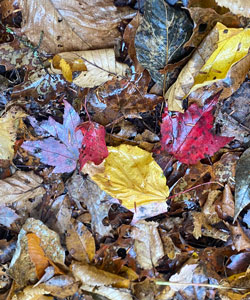
By Linda Wiggen Kraft,
The Healthy Planet Green & Growing Editor
As the leaves turn brilliant colors and fall to the ground, we can reflect on the amazing beauty and ability of leaves to eat sunlight in the miracle of photosynthesis. Leaves inhale carbon dioxide and exhale oxygen in this process. They take in carbon from the atmosphere and transfer it into the trunk, stems and roots of trees and plants. The role that each leaf undertakes is absolutely essential for life on earth and yet we often are oblivious to this miracle that takes place each second in the life of a leaf.
Robin Wall Kimmerer, who is a botanist, Professor of Environmental and Forest Biology, director of the Center for Native Peoples and the Environment at State University of New York College of Environmental Science and Forestry, MacArthur Genius Award Fellow and author of the best seller book Braiding Sweetgrass, once said if she could do anything at all she would choose to photosynthesize. As a Native American she grew up with native traditions honoring the life of plants and earth. Since childhood she has honored all life forms of earth. If anyone knows photosynthesis, she does.
Photosynthesis is only part of the miracle of leaves though. Leaves are food and shelter for many animals including birds, insects, spiders, amphibians, snakes and more. After leaves fall to the ground they are just as important as when hanging on a tree, shrub or other plant. They provide nesting materials for birds, squirrels and other tree dwellers. Fallen leaves are shelter for the animals that live in leaf debris. Many butterflies and moths lay their eggs on leaves or their caterpillars wrap themselves up in the leaves. They stay on the fallen leaves overwinter and emerge in the spring. If the leaves are blown or raked away so are the insects.
In giving thanks to leaves, make sure they are left on the ground over winter. It is best to leave them where they fall. Once caterpillars emerge in the spring, they need to crawl up to new leaves for food to survive. In turn the caterpillars are essentials for birds to feed newly hatched young. Leaves can be raked off lawns into nearby flowerbeds. Leave the leaves on the ground until spring weather warms up to fifty degrees for three or four days in a row. At that temperature the insects will have emerged. As the new leaves of spring emerge, give thanks to them for sustaining life all year round.
Linda Wiggen Kraft is a landscape designer of holistic and organic gardens. She is also an artist and creativity workshop leader. Find out more, subscribe to her blog and Instagram at www.CreativityForTheSoul.com, Call her at 314 504-4266.


